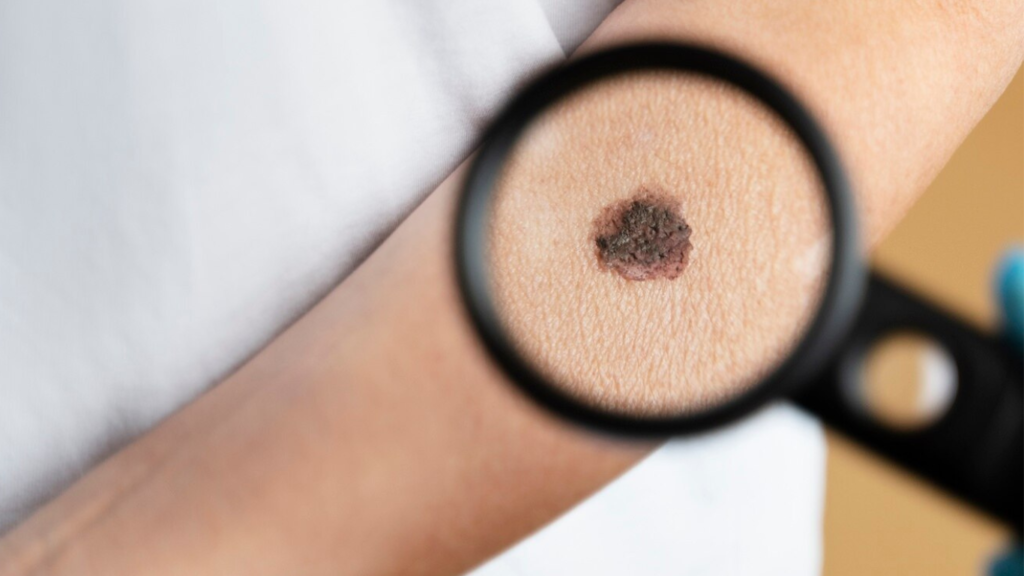Skin cancer is one of the most common types of cancer, but it is also highly treatable when detected early. Regular self-examinations and awareness of the signs can make a significant difference. Here’s a guide to help you detect skin cancer in its early stages.
Skin Cancer A Comprehensive Guide

Know the Types of Skin Cancer
Skin cancer is primarily categorized into three main types: Basal Cell Carcinoma (BCC), Squamous Cell Carcinoma (SCC), and Melanoma. Each type varies in appearance, behavior, and severity. Here’s an overview of each type:
1. Basal Cell Carcinoma (BCC)
- Appearance: BCC often appears as a small, shiny, pearly bump or nodule. It may also look like a scar, a reddish patch, or an open sore that doesn’t heal.
- Common Locations: It typically develops on areas of the skin that are frequently exposed to the sun, such as the face, neck, ears, chest, and back.
- Behavior: BCC is the most common and least aggressive type of skin cancer. While it rarely spreads to other parts of the body, it can grow deeper into the skin and damage surrounding tissues if left untreated.
2. Squamous Cell Carcinoma (SCC)
- Appearance: SCC can appear as a firm, red nodule or a flat, scaly, or crusted patch. It may also present as an ulcer or an open sore that bleeds or doesn’t heal properly.
- Common Locations: SCC is often found on sun-exposed areas such as the face, ears, neck, chest, backs of the hands, or arms.
- Behavior: Although SCC is more aggressive than BCC, it is still treatable. If left untreated, SCC can spread to nearby tissues or lymph nodes, making it more dangerous.

3. Melanoma
- Appearance: Melanoma usually develops in existing moles or as new dark spots. The mole may change in size, shape, or color, often becoming asymmetrical with uneven borders. Melanomas can be black, brown, or even red, blue, or white.
- Common Locations: Melanomas can develop anywhere on the body, but they are more common on the back, legs, or arms.
- Behavior: Melanoma is the most serious form of skin cancer and is responsible for the majority of skin cancer deaths. It has a high potential to spread to other parts of the body if not detected early, making prompt treatment essential.
4. Other Types of Skin Cancer
While BCC, SCC, and melanoma are the most common types, there are rarer types of skin cancer, including:
- Merkel Cell Carcinoma: A rare and aggressive form of skin cancer that appears as firm, painless, shiny nodules.
- Kaposi Sarcoma: Often linked to HIV/AIDS or immune system suppression, this cancer presents as purple or red patches on the skin.
Perform Regular Self-Examinations
Performing regular self-examinations is a simple yet effective way to detect skin cancer early. By checking your skin for unusual changes once a month, you can identify potential warning signs and seek medical advice promptly. Here’s a step-by-step guide:
1. Create the Right Environment
- Choose a well-lit room with a full-length mirror and a handheld mirror.
- Make sure you can see all areas of your body, including hard-to-reach spots.
2. Know What to Look For
Pay attention to:
- New moles or spots.
- Changes in the size, shape, or color of existing moles.
- Sores that don’t heal.
- Spots that are itchy, tender, or bleed.
3. Examine Your Entire Body
Follow this systematic approach to check all areas:
1. Face and Scalp:
- Start with your face, focusing on the nose, lips, and ears.
- Use a handheld mirror or ask someone to help you examine your scalp. Part your hair to check for spots.
2. Upper Body:
- Inspect your neck, chest, and torso.
- For women, check under the breasts.
3. Arms and Hands:
- Look at both sides of your arms, including elbows and underarms.
- Examine the tops and palms of your hands, as well as between your fingers and under your nails.
4. Lower Body:
- Check your legs, paying attention to the fronts, backs, and sides.
- Examine your feet, including the soles, between your toes, and under the toenails.
5. Back and Buttocks:
- Use a handheld mirror to inspect your lower back, buttocks, and backs of your thighs.
Take Notes or Photos
- Keep a record of your moles and spots, noting any changes over time.
- Take photographs to compare month to month.
Follow the ABCDE Rule for Melanoma

When examining moles or spots, use the ABCDE rule to identify warning signs:
- A – Asymmetry: One half of the mole doesn’t match the other.
- B – Border: The edges are irregular, blurred, or notched.
- C – Color: Uneven colors, including shades of black, brown, red, or white.
- D – Diameter: Larger than 6mm (about the size of a pencil eraser).
- E – Evolving: Changes in size, shape, or color over time.
Understand Your Risk Factors
Some people are at a higher risk of developing skin cancer, including those who:
- Have fair skin, freckles, or light-colored eyes.
- Spend a lot of time in the sun or use tanning beds.
- Have a family history of skin cancer.
- Have a history of sunburns, especially in childhood.
Protect Your Skin
Taking proactive steps to protect your skin from harmful UV rays is the best way to reduce your risk of skin cancer. Whether you’re outdoors or enjoying time indoors near windows, following these guidelines can help safeguard your skin.

1. Use Sunscreen Daily
- Choose a broad-spectrum sunscreen with SPF 30 or higher to protect against both UVA and UVB rays.
- Apply sunscreen generously to all exposed skin, including your face, ears, neck, and hands.
- Reapply every two hours, or more often if swimming or sweating.
2. Avoid Peak Sun Hours
- The sun’s UV rays are strongest between 10 a.m. and 4 p.m..
- Plan outdoor activities for early morning or late afternoon when the sun is less intense.
- If you must be outside, seek shade whenever possible.
3. Wear Protective Clothing
- Cover your skin with lightweight, long-sleeved shirts and long pants.
- Opt for tightly woven fabrics or clothing labeled with UPF (Ultraviolet Protection Factor).
- Wear a wide-brimmed hat to protect your face, ears, and neck.
4. Protect Your Eyes
- Wear sunglasses that block 100% of UVA and UVB rays.
- Sunglasses also help prevent eye damage and reduce the risk of skin cancer around the eyes.
5. Avoid Tanning Beds
- Tanning beds emit harmful UV radiation, increasing the risk of all types of skin cancer.
- Embrace your natural skin tone and consider sunless tanning products for a safer glow.
6. Use Window Protection
- UV rays can penetrate glass, so apply sunscreen even indoors if you’re near windows.
- Install window films or use UV-blocking curtains for added protection.
7. Be Extra Cautious in Reflective Environments
- Sand, snow, and water reflect sunlight, intensifying UV exposure.
- Take additional precautions like applying sunscreen more frequently in these settings.
8. Keep an Eye on Your Skin
- Perform regular self-examinations to spot early signs of skin damage or cancer.
- Pay close attention to any changes in moles, spots, or other skin features.
When to See a Doctor
If you notice any suspicious changes, schedule an appointment with a dermatologist immediately. Early diagnosis through a professional skin examination can save lives.
Consider Annual Skin Checks
Even if you don’t notice any concerning changes, consider visiting a dermatologist for an annual skin examination, especially if you’re at higher risk.
By staying vigilant and informed, you can significantly reduce the risk of advanced skin cancer. Early detection leads to effective treatment and better outcomes. Take charge of your skin health today.
